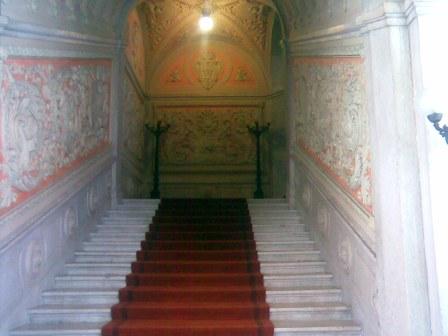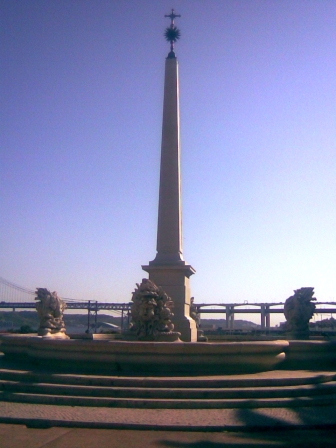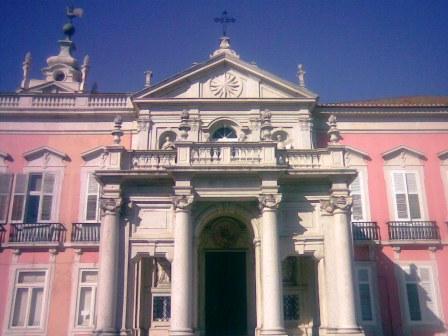Jardim Olavo Bilac, em homenagem ao escritor e um dos mais populares poetas brasileiros, Olavo Bilac (1865-1918).
“A Pátria não é a raça, não é o meio, não é
o conjunto dos aparelhos económicos e políticos:
é o idioma criado ou herdado pelo povo”

-Olavo Bilac-
Este pequeno jardim com traços aristocráticos, também conhecido por Jardim do Largo das Necessidades, situa-se em frente do Palácio das Necessidades, onde desde 1950, está instalado o Ministério dos Negócios Estrangeiros.

-Interior do Palácio das Necessidades (acesso ao Protocolo de Estado)-
Construído em 1747 e cujo projecto foi da responsabilidade do arquitecto Manuel Caetano de Sousa, este jardim é símbolo de um voto de D. João V. Tem um interessante chafariz com o obelisco de mármore rosa e quatro carrancas.

-Chafariz-
É um jardim agradável onde se pode observar o rio Tejo. Do outro lado poderá contemplar a capela do Palácio das Necessidades.
Reza a lenda que em 1580 um casal de tecelões, fugindo à peste refugiou-se na Ericeira. Nesta localidade, o casal tinha por devoção venerar uma imagem da Nossa Senhora da Saúde existente numa pequena ermida.
Por volta de 1604, regressados a Lisboa após o abrandar da peste, o casal decidiu trazer consigo a imagem devota que protegera a sua saúde. A fim de cumprir as promessas de gratidão, o casal decidiu dar início à construção de uma ermida para a referida imagem da Nossa Senhora da Saúde, sob a protecção e o patrocínio de Ana de Gouvêa de Vasconcellos, abastada proprietária da época. Como se situava perto do rio Tejo passou a ser frequente a visita das gentes do mar em busca de protecção e conforto.
Em 1705, o rei D. Pedro II adoece gravemente e solicita que levassem até si a imagem da Nossa Senhora das Necessidades. Recuperado e grato o rei fez retornar a milagrosa imagem à sua ermida, prometendo-lhe, em vida, real protecção.
O rei D. João V continuou a devoção do pai durante os frequentes períodos de enfermidade de que padecia. Como prova de gratidão para com a referida imagem, o rei apropriou-se da ermida e propriedades anexas, ampliando-a e procedendo à construção de um palácio para residir.

-Capela do Palácio das Necessidades-
NOTAS O Palácio das Necessidades está encerrado ao público, mas a capela pode ser visitada de Segunda-Feira a Sexta-Feira das 14:00 às 17:00. Se ainda não conhece a Tapada das Necessidades, mesmo ali ao lado, aproveite e visite a cache do dia de São Valentim, a entrada é gratuita.
A CACHE
É um pequeno rolo de filme de forma circular. Quando o tempo está bom, à noite, é frequente a presença de alguns jovens muggles, por favor sejam discretos.
Olavo Bilac garden, in honor of writer and one of the most popular brazilians poets, Olavo Bilac (1865-1918).

-Olavo Bilac-
This small garden with aristocratic features, also known as Largo das Necessidades garden,is located in front of Palácio das Necessidades, where, since 1950, Ministry of Foreing Affairs is installed.
-The interior of Palácio das Necessidades (access to State Protocol)-
Built in 1747, the project was made by the architect Manuel Caetano de Sousa. This garden it's a symbol of a vote of D. João V, King of Portugal from 1706 to 1750. The garden has an interesting fountain with an obelisk of pink marble and four stone figures.

-Fountain-
It's a nice garden where it is possible see Tagus River. On the other side, you can see the Chapel of Palácio das Necessidades.
Tradition has it that the construction of the Chapel is based on a legend. In 1580, a weaver and his wife fled the plague then rampant in Lisbon, and settled in Ericeira. Whilst there it was their custom to worship a statue of Nossa Senhora da Saúde (Our Lady of Health) located in a small chapel.
In about 1604, on their return to Lisbon following the decline of the plague, the couple decided to bring with them the statue that had protected their health. To fulfil promises of gratitude they determined to build a chapel for the statue of Our Lady of Health and construction duly began under the protection and patronage of Ana de Gouvêa de Vasconcellos, a rich landowner of the time.
As it was located in the Alcântara dock by the river Tagus the chapel soon became a compulsory stopping place for seafarers who appealed to the statue to protect their health and fulfil other needs. As time passed this holy statue of Our Lady of Health became famous and its name was connected with other miracles. The legend of the miracle-working image spread rapidly amongst the population.
Struck by a serious illness in 1705, King Pedro II asked that the statue of Our Lady of Needs be brought to his presence. Once recovered and duly grateful, the king had the miraculous statue returned to its chapel and promised it royal protection during his lifetime.
King João V continued his father's devotion during the many times he was ill. To show his gratitude to the statue the king took possession of the chapel and the adjacent land "in the name of His Majesty and for his Royal Service" declaring them "the property of the aforesaid 'Quinta da Sua Ermida de Nossa Senhora das Necessidades' and of all its belongings and trappings". In gratitude the king enlarged the chapel and built a palace. He also ordered a convent to be built, designated as a hospice, to house priests who were to dedicate their lives to the teaching of theology, the humanities and science.
The task was a considerable one and small adjacent properties were acquired so as to enlarge the close as well as design the convent and palace gardens. When work on the convent finished the Oratorian Congregation of Lisbon applied to the king for permission to occupy the premises.

-Chapel of Palácio das Necessidades-
NOTES
The Palácio das Necessidades is closed to the public, but the chapel can be visited from Monday to Friday from 2:00 pm to 5:00 pm.
If you don't know the Tapada das Necessidades you can visit and found this cache, the entrance is free.
THE CACHE
It's a small circular cannister container. When the weather is good, at night, usually there are young muggles in the area, please be discreet.